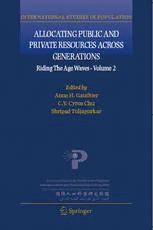Table Of ContentALLOCATINGPUBLICANDPRIVATE
RESOURCESACROSSGENERATIONS
International Studies in Population
Volume3
TheInternationalUnionfortheScientificStudyofPopulation(IUSSP)
TheIUSSPisaninternationalassociationofresearchers,teachers,policymakersandothers
fromdiversedisciplinessetuptoadvancethefieldofdemographyandpromotescientific
exchange.Italsoseekstofosterrelationsbetweenpersonsengagedinthestudyofdemo-
graphyandpopulationtrendsinallcountriesoftheworldandtodisseminateknowledge
abouttheirdeterminantsandconsequences.ThemembersoftheIUSSPscientificgroup
responsibleforthisbookwerechosenfortheirscientificexpertise.Thisbookwasreviewed
byagroupotherthantheauthors.WhiletheIUSSPendeavourstoassuretheaccuracyand
objectivityofitsscientificwork,theconclusionsandinterpretationsinIUSSPpublications
arethoseoftheauthors.
International Studies in Population (ISIP) is the outcome of an agreement concluded
byIUSSPandSpringerin2004.Thejointseriescoversthebroadrangeofworkcarried
out by IUSSP and includes material presented at seminars organized by the IUSSP. The
scientificdirectionsoftheIUSSParesetbytheIUSSPCouncilelectedbythemembership
andcomposedof:
JacquesVallin(France),President
HaniaZlotnik(Mexico),Vice-President
MaryM.Kritz(USA),SecretaryGeneralandTreasurer
AlakaBasu(India) ZebaSathar(Pakistan)
∗ ∗
GraziellaCaselli (Italy) AlanSimmons (Canada)
JohnCasterline(USA) JamesTrussell(USA)
∗
DavidColeman (UK) ZengYi(China)
PeterMcDonald(Australia)
∗
PublicationCommittee
Allocating Public and Private
Resources across Generations
Riding the Age Waves—Volume 2
Editedby
ANNEH.GAUTHIER
UniversityofCalgary,
Alberta,Canada
C.Y.CYRUSCHU
AcademiaSinica,
Taipei,Taiwan
and
SHRIPADTULJAPURKAR
StanfordUniversity,
California,U.S.A.
AC.I.P.CataloguerecordforthisbookisavailablefromtheLibraryofCongress.
ISBN 978-1-4020-4790-9(PB)
ISBN 978-1-4020-4480-9(HB)
ISBN 978-1-4020-4481-6(e-book)
PublishedbySpringer,
P.O.Box17,3300AADordrecht,TheNetherlands.
www.springer.com
Printedonacid-freepaper
AllRightsReserved
(cid:3)C 2007 Springer
Nopartofthisworkmaybereproduced,storedinaretrievalsystem,ortransmittedinanyformor
byanymeans,electronic,mechanical,photocopying,microfilming,recordingorotherwise,without
writtenpermissionfromthePublisher,withtheexceptionofanymaterialsuppliedspecificallyfor
thepurposeofbeingenteredandexecutedonacomputersystem,forexclusiveusebythe
purchaserofthework.
CONTENTS
Preface vii
Acknowledgements ix
TheAuthors xi
Introduction 1
AnneH.Gauthier,C.Y.CyrusChu,andShripadTuljapurkar
1. SubstitutionandSubstitutability:TheEffectsofKinAvailability
onIntergenerationalTransfersinMalawi 13
AlexanderA.Weinreb
2. KinshipNetworksandIntergenerationalTransfers 39
C.Y.CyrusChuandRuoh-RongYu
3. StabilityandChangeinPatternsofIntergenerationalTransfersinTaiwan 63
I-FenLin,NoreenGoldman,MaxineWeinstein,andYu-HsuanLin
4. DemographicEventsandtheTimingofMonetaryTransfers:
SomeEvidencefromGermany 89
SumonKumarBhaumik
5. MaternalCoresidenceandContact:Evidencefrom
Cross-NationalSurveys 117
JudithTreasandPhilipN.Cohen
6. SonPreference,Marriage,andIntergenerationalTransferinRuralChina 139
MarcusW.Feldman,ShripadTuljapurkar,ShuzhuoLi,XiaoyiJin,
andNanLi
7. HealthandLabour-ForceParticipationoftheElderlyinTaiwan 163
CemMeteandT.PaulSchultz
v
vi CONTENTS
8. SocialExpendituresonChildrenandtheElderlyinOECDCountries,
1980–1995:ShiftingAllocations,ChangingNeeds 201
JanetC.Gornick
9. ConsequencesofEducationalChangefortheBurdenofChronicHealth
ProblemsinthePopulation 227
MarkD.Hayward,EileenM.Crimmins,andZhenmeiZhang
10. EffectsofChangingAgeStructureandIntergenerationalTransfers
onPatternsofConsumptionandSaving 243
DianeJ.Macunovich
11. SomeIntergenerationalTransferImplicationsofBirthFluctuations 279
RobertSchoenandStefanJonsson
12. OnStochasticGenerationalAccounting 291
JuhaM.AlhoandReijoVanne
Index 305
PREFACE
SHRIPADTULJAPURKAR
C.Y.CYRUSCHU
ANNEH.GAUTHIER
NAOHIROOGAWA
IANPOOL
Beginninginthelastcenturyandcontinuingintothe21stcentury,thepopulationsofthe
world’snationshavedisplayedlargeandlong-livedchangesinagestructure.Manyofthese
beganwithfertilitychangeintheformofbabybooms,busts,ordeclines,andareamplified
bydecliningmortalityandbymigrationwithinandbetweennations.Theseage-structural
transitionshavepowerfuleffectsonhumanaffairs,fromdrivingthedemandforpublicand
privategoodsandservicesforyoungandold,todeterminingtheflowofresourcesacross
thedifferentagesofthehumanlifecycle.Theconsequencesofage-structuraltransitions
vary in emphasis and detail, but not in significance, across the spectrum of nations in
differentstagesofeconomicdevelopment.Demographywillmatterinthiscenturynotby
forceofnumbers,butbythepressuresofwavesofage-structuralchange.
In 1997 a committee of the International Union for the Scientific Study of Populations
was charged with exploring age-structural transitions and their policy implications. The
committeebroughttogetherdistinguishedscientiststoexaminethekeydemographic,so-
cial,economic,andpolicyaspectsofage-structuralchangeacrossaspectrumofnations
at different stages of development. Readers will find a rich discussion of their work in
RidingtheAgeWaves,aseriesofthreebooks,“Population,Resources,andDevelopment,”
“AllocatingPublicandPrivateResourcesacrossGenerations,”and“ResponsestoAgeing
in Advanced Industrial States.” Volume 1 of the series contains discussions focused on
developingcountriesandchallengesfrombuildinghumancapabilitiesandcreatingjobsto
creatingindustry,infrastructure,andinstitutions.Volume3oftheseriescontainsdiscus-
sionsfocusedonthehighlyindustrializedcountriesandpolicyproblemsrelatedtoageing
andlongrunsub-replacementfertility.
The subject of this volume (volume 2) is intergenerational transfers, by which we mean
transfersofallkinds(money,goods,services,time,culture,taxesandbenefits,information,
socialcapital)acrossgenerations.Someofthediscussionalsoconcernsintragenerational
transfersthatareoftennaturallyintertwinedwithtransfersacrosstheagespectrum.
Whyareintergenerationaltransfersimportantinanageofchangingdemographicstruc-
tures?Intergenerationaltransfersareakeydeterminantofthewell-beingofindividualsand
vii
viii PREFACE
families,andofaggregatehuman,social,andfinancialcapital.Intergenerationaltransfers
oftime,money,goods,andattitudesfromparentstoyoungchildrencontributetochildren’s
educationalachievementandlateremploymenttrajectories,andtointergenerationalclass
mobility.Similarly,intergenerationaltransfersfromgrown-upchildrentoelderlyparents
havebeenshowntocontributetoparents’well-being.Atamacrolevel,thedirectionand
magnitude of intergenerational transfers has been proposed as a key factor determining
fertilitytransitionsandlevels.Inthereversedirection,patternsofintergenerationaltrans-
ferarestronglyaffectedbyshiftsinagestructure,kinshipstructure,andsocialnetworks.
Themacroeconomicsofpopulationsundergoingfertilityandmortalitytransitionscanbe
usefullyanalysedintermsofintergenerationalflowstoilluminatequestionsrangingfrom
savingsratestotheneedforpublicsupporttodifferentagesegmentsofthepopulation.
In many industrialized countries, population age structures today reflect large fertility
declinesthatoccurredagenerationorsoago,withresultingbabyboomsthathaveaged
andaremovingthroughthelabourforce.Fertilitydeclineshavehadandcontinuetohave
significant social and economic effects, e.g., on the growth of individual savings and
thus aggregate capital investment, on family sizes and the shift from traditional family
structures toward nuclear families, and on the thinning of traditional kinship networks.
Mortalitydeclineshaveresultedinrapidgrowthoftheelderlypopulationandanincrease
in old-age dependency ratios in both population, and families. Thus, the joint effects of
intergenerational transfers and age-structural transitions will have short- and long-run
effectsonpolicywithrespecttoeducation,socialservices,welfare,old-agesupport,and
onmacroeconomicandfiscalpolicy.
Several features distinguish these books from past writing on the subject. First, a joint
examination of dimensions of age-structural change that have often been considered in
isolation from each other (for example, in multidimensional measurement of transfers,
andincross-nationalcomparisons);second,thepapersherebringtogetherthemanypol-
icy implications of these dimensions; third, the use of case studies to examine policy
consequencesandoptionsofparticulardimensionsofchange;fourth,thedevelopmentof
qualitativeandformalmethodstoanalysethelong-termdynamicnatureandconsequences
ofage-structuralchange.
Thecommittee(ShripadTuljapurkar,C.Y.CyrusChu,AnneH.Gauthier,NaohiroOgawa,
RafaelRofman,IanPool,HassanYoussif)thanksthemanypeopleandagencieswhomade
thisworkpossible.InadditiontotheIUSSP,wethanktheAsianMetacentreattheSingapore
NationalUniversity,theAcademiaSinicainTaipei,andtheNihonUniversityPopulation
ResearchInstituteinTokyo.TheeditorsoftheindividualvolumeswereC.Y.CyrusChu,
AnneH.Gauthier,NaohiroOgawa,IanPool,VipanPrachuabmoh,andShripadTuljapurkar.
ACKNOWLEDGEMENTS
ThisbookistheresultofanIUSSP(InternationalUnionfortheScientificStudyofPopula-
tion)seminaronAgeStructureTransitionsandPolicyDynamics:TheAllocationofPublic
and Private Resources across Generations held in Taipei, Taiwan December 6–8, 2001.
TheseminarwasorganizedbytheIUSSPCommitteeonAgeStructureandPublicPolicy
(ShripadTuljapurkar,Chair,C.Y.CyrusChu,AnneH.Gauthier,NaohiroOgawa,IanPool,
Rafael Rofman, Hassan Yousif) and the Institute of Economics of Academia Sinica. An
editorialcommitteereviewedaselectedsubsetofthemanyexcellentpaperspresentedat
themeeting.Followingtheusualpracticesinthisandthepreviousseriestherevisedsetof
chapterswassubjecttoindependentscrutinythroughtheIUSSP.Theeditorsandexternal
reviewersrequestedrevisionsandthefinalrevisedpapersareincludedinthisvolume.
ix

